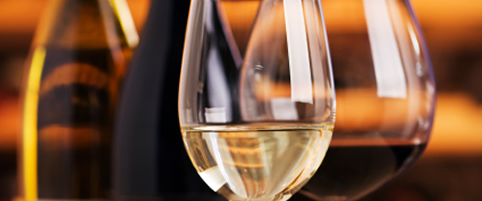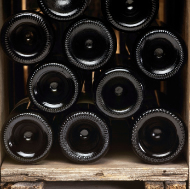Wines
Glossary
Acid:
This is a component of all grapes; too much acidity will make the wine unbalanced and sharp or sour. If the wine has well-balanced acidity it will help keep the wine fresh, zesty and clean. Wines with good acidity will be crisp, fresh, lemony and refreshing. Wines with too little acidity will taste �flabby�.
Alcohol:
Present in all wines; bigger full-bodied wines will be much higher in alcohol (~14%) than light crisp whites (~11.5%). Alcohol also helps to enhance the flavour and feel of a wine.
Appellation:
A place name identifying a specific geographic area that can be applied to agricultural products including wines which are grown and/or produced there.
Aromatic:
A common word that you will see in tasting notes, an aromatic wine will have a distinct pleasant smell e.g. Sauvignon Blanc
B | To index
Balanced:
All winemakers attempt to make a well-balanced wine, one where the elements of fruit, tannin and acidity are in harmony.
Barrel:
A huge topic, but many quality wines are fermented and/or aged in barrels. These are made of oak. The most common sizes are 225 Litres. There are two types of oak used to make barrels; French and American oak. French oak gives more subtle toasty flavours while American oak gives much stronger vanilla oak flavours. Brand new barrels will give more oak flavour than a one or two year old barrel.
Barrel Fermented:
Most wines are fermented in tanks and then aged in oak. However, some wines are fermented in oak barrels. This is an expensive way of making wines and the end result is usually a wine with great depth and complexity.
Buttery:
Many top White Burgundy wines (and New World Chardonnays) are described as being buttery due to the fermentation and oak ageing process.
C | To index
Chalky:
Used to describe the texture of a wine.
Chewy:
These are wines (usually red) that have lots of grape skin extracts such as tannin giving the impression of being really thick and full in the mouth.
Clean:
Simply, a wine that is free of faults, fresh tasting and pleasant although it can sometimes refer to a wine that is technically correct but not overly exciting.
Coarse:
Wine that is unsubtle and rough tasting is coarse � a bit too tannic, too acidic. Unbalanced might be more correct; rustic might be more diplomatic.
Complex:
A very good quality wine offering a myriad of aromas and flavours, layer upon layer coating your tongue in an explosion of flavour.
Concentrated:
Seems as though the wine�s flavours concentrate along the centre of your palate; often found in wines made from low yields or old vines.
D | To index
Decanting:
Decanting is done for two primary reasons. If there is sediment in the bottle, decanting will allow sediment to be separated from the wine (older red wines and vintage ports), or to �open� wines that are �closed� (red or white wines). Pouring wine into a decanter allows contact with air, which may bring out flavours that would otherwise take several years to appear.
E | To index
Earthy:
Many aromas and flavours fall under this description, in a positive way. Italian reds, Pinot Noir and many older reds often leave an impression of having wet clay, forest floor or sweet soil in the bottle.
F | To index
Fat:
A wine that fills the mouth. It can indicate that the wine does not have enough acidity to balance it up (thin being the opposite), however it is not always a fault in a wine.
Fining:
The process of adding an agent to remove tiny particles that might cause a haze as the wine ages. Agents include: egg white, betonite clay, gelatin and casin. No traces of these agents will exist in the wine.
Filtering:
A clarification process using filters to ensure that the wine is crystal clear and bright. Some claim that both fining and filtration might strip the wine of some of its flavour and character, thus some producers choose to label their wine unfiltered or unfined.
Floral:
Literally smelling of flowers.
Fruity:
Smelling or tasting strongly of fruit. But which fruit? Some grape varieties have distinctive fruit aromas associated with them � e.g. lychees of Gewurtztraminer, the blackcurrant of Cabernet Sauvignon. Some wines, especially blends, just smell broadly of �red fruits� or �citrus fruits�.
Full-bodied:
A wine that fills the mouth and seems to impose on the palate � in contrast with medium or light-bodied wines, which make a less imposing impression.
G | To index
Gamey:
Similar territory to the earthy range of smells � gamey, leathery, meaty smells and flavours often appear in older red wines.
Grapey:
Very few wines actually smell like grapes, with wines made from the Muscat grape being a notable exception.
H | To index
Herbaceous:
Often used to describe the nose of a Sauvignon Blanc. It is a positive description. However, the term herbaceous can also be used to describe negative flavour such as where the grapes that made the wine were under-ripe � for example red wines grown in very cool climates may be herbaceous.
Honeyed:
Wine showing a strong aroma or palate of honey; usually associated with older whites, especially wooded dry whites such as Chardonnay or an aged Riesling, and sweeter botrytis-affected wines.
Hot:
Wines made form overripe grapes grown in warm climates can produce a hot-tasting burn of alcohol at the back of the throat. The fruit in those wines can also taste a bit jammy.
L | To index
Lees:
The dead yeast cells, the bits of pulp, the seeds and some bits of skin and stalk that fall to the bottom of the tank, barrel or vat of fermenting wine. Also refers to the dead yeast cells that fall to the bottom of a bottle of sparkling wine after its second fermentation.
Often a wine is left on the lees to gain extra flavour and complexity.
Long:
A wine that has a long finish is one whose flavours seem to go on and on for seconds, right down the back of your throat. The opposite, obviously, is a wine with a short finish, which is not as enjoyable.
M | To index
Mousse:
To sparkling wine what the head is to beer. A good sparkling wine should have a mousse that remains in the glass for the duration of the drink and the bubbles that form it (called the bead) should be as small as possible.
N | To index
Nutty:
Flavours of nuts � hazel, brazil, almond, cashews. Often it is a reflection of the wine making process (e.g. from storage in oak barrels esp. Chardonnay) or it is the character of the variety (Pinot Gris).
O | To index
Oaky/Oaked:
A catchall term that covers all sorts of descriptions from the vanilla-like smell of new oak barrels to the cedar wood smell of old Cabernet Sauvignon, the toasty smells, and the spicy smells.
Oily:
Occasionally white wines like Viognier or Marsanne, aged Riesling or Semillon can have a slippery, oily texture to them that is actually very attractive.
R | To index
Reserve:
Strictly refers to wines reserved from previous vintages (years) that are used as important blending components in the production of, for example, non-vintage sparkling wine or Rioja to give extra character and complexity to the new wine. Used loosely in many New World countries as a general indication of better-than-average quality e.g. Show Reserve, Special Reserve.
Rich:
Wine with lots of viscosity, flesh, substance and fruit.
S | To index
Smoky:
Some white varieties such as Sauvignon Blanc, Pinot Gris or Gewurtztraminer can make wines with a dusky, smoky perfume. Oak barrels can give wine a different more pungent, smoky, charred aroma.
Soft:
Smooth, elegant, well-balanced, mature, and approachable � all different ways of saying delicious.
Spicy:
Like smoky aromas, spicy characters can come from the grape varieties - the pepperiness of Shiraz for example � or the barrel � the clove and aniseed aromas of French oak.
Sulphur:
An essential additive in winemaking, it has been used to prevent oxidation for thousands of years. The properties of sulphur are that it acts as an antioxidant, antiseptic, bleaching, flavour enhancing and as an anti-oxidasic. Sulphur candles used to be burnt inside barrels to build up a layer of sulphur dioxide. Now it is added to the wine in powdered form. Too much sulphur in a wine may be detected by a prickly sensation on the nose.
T | To index
Tannin:
Gives a distinctive texture and drying sensation on the roof of ones mouth and around the gums. Found in red wine, it is a natural preservative substance originating from grape skins, pips and oak barrels. Tannin gives the wine backbone and good aging potential. Tannins will generally soften over time.
Terroir:
How the unique combination of soil, vineyard's site, climate and grape variety and culture affects the taste of the resulting wine. For the French, the idea of terroir is sacrosanct. New World winemakers are slowly coming to terms with the concept, planting varieties that suit the particular soil and climate of a vineyard site.
Thin:
See fat
U | To index
Ullage:
Given the chance, wine likes to evaporate if it�s kept hanging around. It will evaporate through the cracks and loosely sealed bungs of a barrel and it will leak through a contracting and expanding cork in a bottle. The space that�s left in the barrel and the bottle is the ullage. Barrels can be filled up but most bottles are left to ullage away over the years. Badly ullaged wines whose levels have fallen below the shoulder of the bottle tend to oxidise but a little ullage is not necessarily so harmful.
V | To index
Variety/Varietal:
Two words that are often confused. A grape variety is a type of grape. A varietal wine is made from one variety. Varietal is also used as a tasting term to describe a wine that smells and tastes varietally correct � blackcurrant Cabernet or peppery Shiraz for example.
Vintage (and non-Vintage):
The year in which grapes are picked - that a vintage-designated wine is made from (non-vintage is made from grapes picked over various years).
Viticulture:
The practice of growing vines � in this case, the grapevine, and in particular, the wine grapevine, Vitis vinifera. People who do it are called �viticulturalists�.
W | To index
Woody:
Term used for the dusty smells and the dirty old barrel smells in a wine.
Yeast:
Yeast is the key that unlocks the intoxicating secret of the sugar in the grape juice â�� itâ��s the yeast cells, already in the air, or introduced by the winemaker, that convert the sugar into alcohol, carbon dioxide and heat.Â



